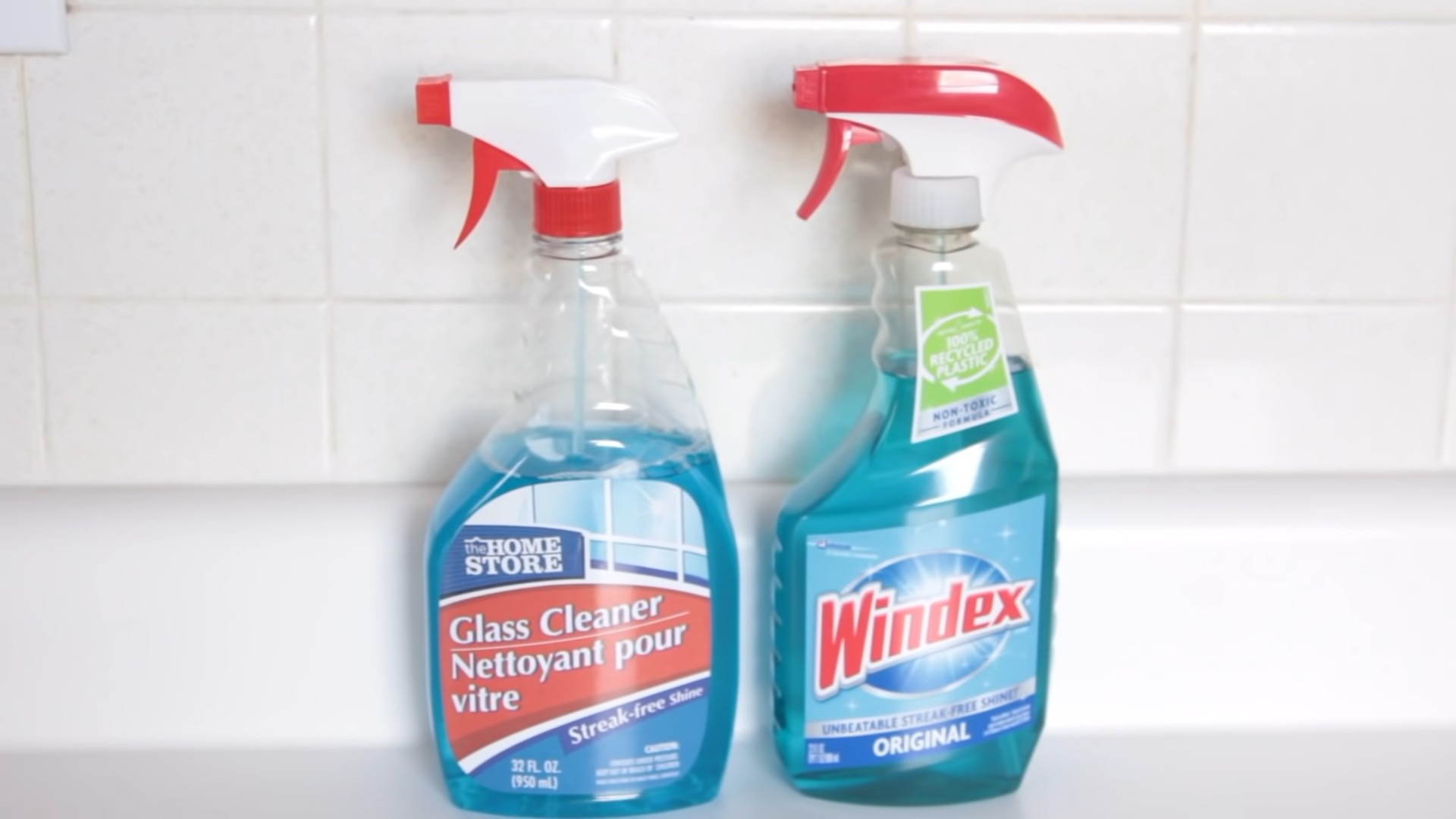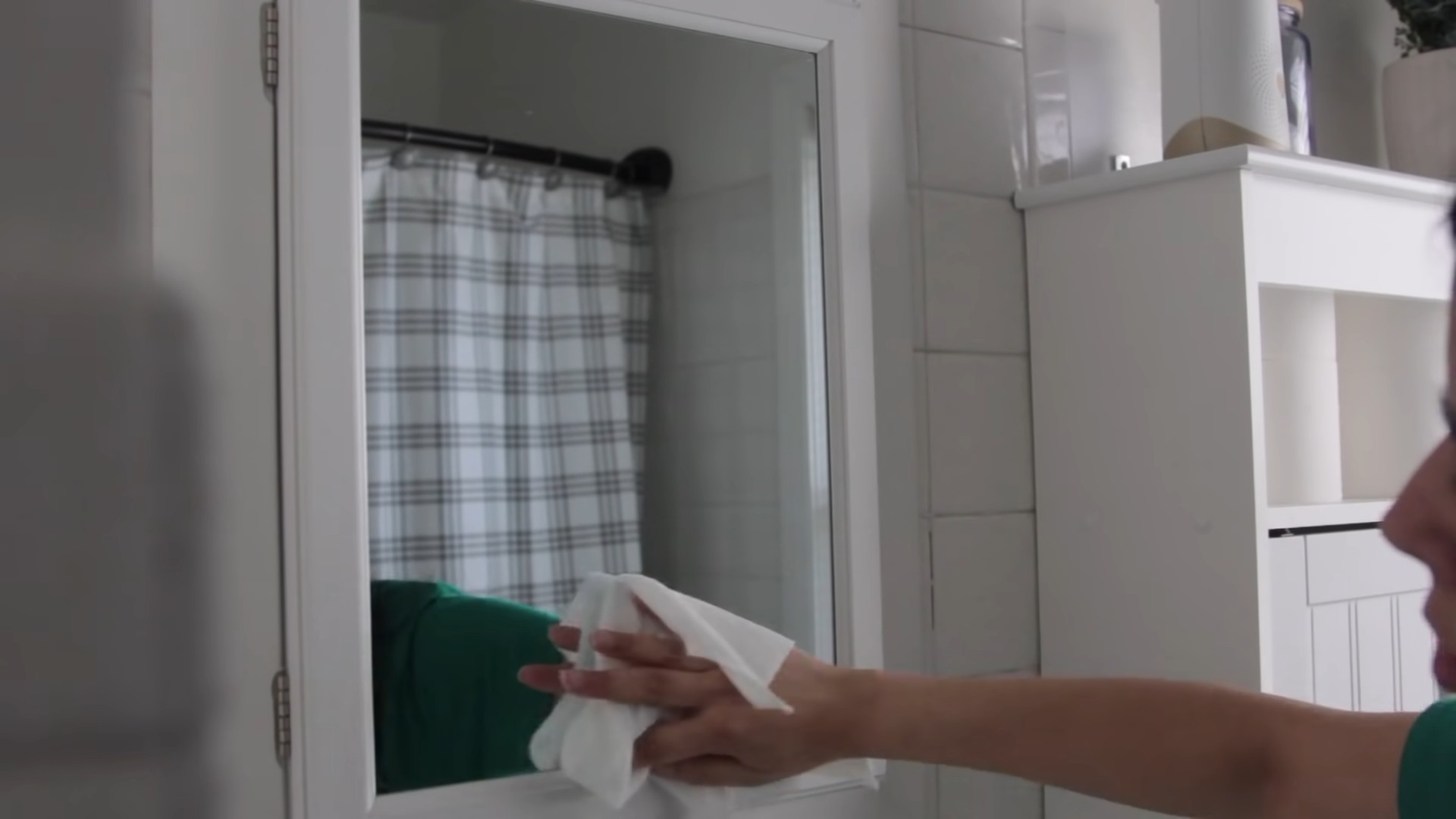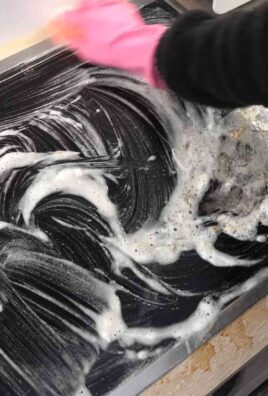Streak Free Glass Cleaning – it’s the holy grail of home maintenance, isn’t it? We’ve all been there, armed with sprays and cloths, only to be left with a frustrating, hazy mess. But what if I told you that achieving sparkling, crystal-clear windows and mirrors is easier than you think, and you probably already have everything you need right in your pantry?
The quest for perfectly clean glass has been around for centuries. Think about the grand palaces of Europe, with their enormous windows reflecting light and grandeur. Maintaining that pristine shine was a sign of wealth and meticulous care. While we might not be cleaning palace windows, we all appreciate the way sunlight streams through spotless glass, brightening our homes and our moods.
Let’s face it, nobody enjoys looking through smudged, streaky windows. It detracts from the beauty of your home and can even impact your well-being. A clear view can boost your mood and connect you with the outdoors. That’s why mastering the art of streak free glass cleaning is so important. This DIY guide will provide you with simple, effective, and budget-friendly tricks and hacks to banish streaks for good. Get ready to say goodbye to frustrating cleaning sessions and hello to sparkling, streak-free glass!

DIY Streak-Free Glass Cleaning Solution and Method
Okay, let’s face it, achieving truly streak-free glass can feel like chasing a unicorn. But fear not! I’m going to share my tried-and-true method for sparkling, crystal-clear windows and mirrors that will make you wonder if the glass is even there. This isn’t just about the solution; it’s about the technique too. So, grab your supplies, and let’s get started!
What You’ll Need: The Arsenal of Clean
Before we dive in, let’s gather our supplies. Having everything ready will make the process smooth and efficient.
* Spray Bottle: A clean, empty spray bottle is essential for dispensing our cleaning solution.
* Microfiber Cloths: These are the unsung heroes of streak-free cleaning. Invest in a few high-quality microfiber cloths specifically designed for glass. Avoid using paper towels, as they can leave lint behind.
* Distilled Water: Tap water can contain minerals that contribute to streaks. Distilled water ensures a pure, clean rinse.
* White Vinegar: This is our natural cleaning powerhouse! Vinegar cuts through grime and leaves a brilliant shine.
* Rubbing Alcohol (Isopropyl Alcohol): This helps the solution evaporate quickly, minimizing streaks.
* Optional: A few drops of essential oil (Lemon, Lavender, or Tea Tree): This is purely for fragrance. Choose your favorite scent, but don’t overdo it!
* Bucket (Optional): For pre-cleaning heavily soiled glass.
* Squeegee (Optional): For large windows, a squeegee can be a game-changer.
* Ladder or Step Stool (If needed): Safety first!
Mixing the Magic: The Cleaning Solution Recipe
Now for the secret sauce! This cleaning solution is simple, effective, and uses ingredients you probably already have.
1. Combine Ingredients: In your spray bottle, combine the following:
* 1 cup distilled water
* 1/4 cup white vinegar
* 1/4 cup rubbing alcohol
* Optional: 5-10 drops of your favorite essential oil.
2. Shake Well: Secure the spray nozzle and shake the bottle thoroughly to ensure all ingredients are well mixed.
The Cleaning Process: Step-by-Step to Sparkling Glass
Alright, let’s get down to business! This is where the magic happens. Follow these steps carefully for the best results.
1. Pre-Cleaning (If Necessary): If your glass is particularly dirty (think splattered mud, bird droppings, or greasy fingerprints), you’ll want to pre-clean it. Fill a bucket with warm water and a small amount of dish soap. Use a sponge or cloth to wash the glass, then rinse with clean water. This step removes the heavy grime and prevents it from being smeared around during the main cleaning process.
2. Spray the Glass: Lightly mist the glass surface with your cleaning solution. Don’t over-saturate it! A thin, even layer is all you need.
3. Wipe with a Clean Microfiber Cloth: Immediately after spraying, wipe the glass with a clean, dry microfiber cloth. Use overlapping strokes, working from top to bottom. Apply gentle pressure to remove any remaining dirt or residue.
4. Buff to a Shine: This is the key to streak-free results! Take a second, clean, dry microfiber cloth and buff the glass until it’s completely dry and sparkling. Use circular motions to remove any lingering streaks or water spots.
5. Squeegee Technique (Optional): If you’re using a squeegee, overlap each stroke slightly, wiping the blade clean after each pass. Wipe up any drips with a clean microfiber cloth.
6. Inspect and Touch Up: Once you’ve finished cleaning, take a step back and inspect your work. If you see any remaining streaks or spots, lightly mist the area with the cleaning solution and buff again with a clean microfiber cloth.
7. Repeat as Needed: For heavily soiled glass, you may need to repeat the cleaning process a second time.
Tips and Tricks for Glass Cleaning Success
Here are a few extra tips to help you achieve the best possible results:
* Use Clean Cloths: Always use clean microfiber cloths. Dirty cloths will only smear dirt and leave streaks. Wash your microfiber cloths regularly in hot water with a mild detergent. Avoid using fabric softener, as it can reduce their absorbency.
* Work in Sections: For large windows or mirrors, work in smaller sections to prevent the cleaning solution from drying before you have a chance to wipe it away.
* Avoid Direct Sunlight: Cleaning glass in direct sunlight can cause the cleaning solution to dry too quickly, leading to streaks. Choose a cloudy day or clean in the early morning or late afternoon.
* Clean from Top to Bottom: This prevents drips from running down onto already cleaned areas.
* Don’t Over-Spray: Using too much cleaning solution can actually make it harder to achieve a streak-free finish. A light mist is all you need.
* Replace Your Microfiber Cloths Regularly: Even with proper care, microfiber cloths will eventually wear out. Replace them when they start to lose their absorbency or become frayed.
* Test in an Inconspicuous Area: Before cleaning an entire window or mirror, test the cleaning solution in a small, inconspicuous area to ensure it doesn’t damage the surface. This is especially important for antique or delicate glass.
* Clean Windows on a Cloudy Day: Direct sunlight can cause the cleaning solution to dry too quickly, leading to streaks.
* Use a Ladder Safely: If you need to use a ladder to reach high windows, be sure to follow all safety precautions. Have someone spot you, and never overreach.
* Clean Window Screens: Dirty window screens can transfer dirt and grime onto your freshly cleaned windows. Clean your screens regularly to keep your windows looking their best. You can use a brush, vacuum cleaner, or garden hose to clean your screens.
* Clean Window Tracks: Don’t forget to clean the window tracks! These areas can accumulate dirt, dust, and debris, which can then be transferred onto your windows. Use a small brush or vacuum cleaner to remove any loose debris, then wipe the tracks with a damp cloth.
* Homemade Glass Cleaner Variations: While my recipe is a winner, feel free to experiment! Some people swear by using newspaper instead of microfiber cloths (though I find microfiber superior). Others add a tablespoon of cornstarch to the solution for extra shine. Find what works best for you!
* Stubborn Stains: For stubborn stains like hard water spots, try using a paste of baking soda and water. Apply the paste to the stain, let it sit for a few minutes, then scrub gently with a non-abrasive sponge. Rinse thoroughly with clean water and dry with a microfiber cloth.
* Grease and Grime: For greasy fingerprints or kitchen splatters, try adding a few drops of dish soap to your cleaning solution. Be sure to rinse thoroughly to remove any soap residue.
* Preventative Measures: To keep your windows cleaner for longer, consider applying a rain repellent product. These products create a hydrophobic barrier that repels water and dirt, making it easier to clean your windows in the future.
Troubleshooting: Common Glass Cleaning Problems and Solutions
Even with the best techniques, you might encounter a few challenges. Here’s how to tackle them:
* Streaks: The most common problem! Make sure you’re using clean microfiber cloths and buffing the glass completely dry. Also, avoid using too much cleaning solution.
* Smears: Smears are often caused by dirty cloths or residue from previous cleaning products. Wash your cloths thoroughly and rinse the glass well.
* Water Spots: Water spots are caused by mineral deposits in tap water. Use distilled water in your cleaning solution to prevent them.
* Lint: Lint is usually caused by using paper towels or low-quality cloths. Switch to high-quality microfiber cloths.
* Hazy Film: A hazy film can be caused by residue from cleaning products or hard water. Try using a solution of equal parts white vinegar and water to remove the film.
Maintaining Your Sparkling Glass: A Routine for Success
Once you’ve achieved streak-free glass, you’ll want to keep it that way! Here’s a simple maintenance routine:
* Regular Dusting: Dust your windows and mirrors regularly with a dry microfiber cloth to remove loose dirt and debris.
* Spot Cleaning: Clean up any spills or splatters immediately to prevent them from drying and becoming difficult to remove.
* Deep Cleaning: Deep clean your windows and mirrors every few months, or as needed, using the cleaning solution and method described above.
By following these tips and tricks, you’ll be able to achieve streak-free glass every time. Happy cleaning!

Conclusion
So, there you have it! Achieving sparkling, streak-free glass doesn’t require expensive, chemical-laden commercial cleaners. This simple, DIY glass cleaning solution is not only incredibly effective but also eco-friendly and budget-conscious. We’ve shown you how to harness the power of readily available ingredients to create a cleaner that rivals, and often surpasses, store-bought alternatives.
Why is this DIY trick a must-try? Because it delivers exceptional results without the harsh chemicals that can irritate skin, harm the environment, and leave behind lingering odors. You’re in complete control of the ingredients, ensuring a safe and healthy cleaning experience for your entire family. Plus, you’ll save money in the long run by avoiding constant repurchases of expensive glass cleaners.
But the beauty of this DIY approach lies in its adaptability. Feel free to experiment with variations to suit your specific needs and preferences. For instance, if you have particularly stubborn grime, you can increase the vinegar concentration slightly. If you prefer a scented cleaner, add a few drops of your favorite essential oil, such as lemon, lavender, or tea tree oil (known for its antibacterial properties). Just be sure to use essential oils sparingly, as too much can leave a residue. Another variation involves using distilled water instead of tap water, especially if you live in an area with hard water. Distilled water is free of minerals that can sometimes contribute to streaks.
Consider using this DIY solution not just on windows and mirrors, but also on glass shower doors, car windows, and even glass stovetops. The versatility of this cleaner makes it a true all-purpose solution for achieving a sparkling home.
This DIY streak free glass cleaning solution is a game-changer for anyone seeking a natural, effective, and affordable way to maintain crystal-clear glass surfaces. It’s a small change that can make a big difference in the cleanliness and overall ambiance of your home.
We wholeheartedly encourage you to give this DIY trick a try. We’re confident that you’ll be amazed by the results. Once you’ve experienced the satisfaction of streak-free glass achieved with your own homemade cleaner, we’d love to hear about your experience! Share your tips, variations, and before-and-after photos in the comments below. Let’s build a community of DIY enthusiasts who are passionate about clean, healthy, and sustainable living. Your feedback will not only help others but also inspire us to continue sharing valuable DIY solutions. So, grab your ingredients, mix up a batch, and prepare to be amazed by the power of homemade cleaning!
Frequently Asked Questions (FAQ)
What kind of vinegar should I use?
White distilled vinegar is the best choice for this DIY glass cleaner. It’s inexpensive, readily available, and has a high acidity level that effectively cuts through grime and grease. Avoid using other types of vinegar, such as apple cider vinegar or balsamic vinegar, as they may contain sugars or other compounds that can leave a residue on your glass. The clarity and purity of white distilled vinegar are key to achieving a streak-free finish.
Can I use this cleaner on tinted windows?
While this DIY cleaner is generally safe for most types of glass, it’s always a good idea to test it on an inconspicuous area of tinted windows first. Some window tints can be sensitive to acidic solutions like vinegar. Apply a small amount of the cleaner to a corner of the window and observe for any discoloration or damage. If you notice any adverse effects, discontinue use. If the test area looks fine, you can proceed with cleaning the entire window.
How often should I clean my windows with this solution?
The frequency of cleaning depends on several factors, including the location of your windows, the weather conditions, and the amount of dirt and dust they accumulate. Windows that are exposed to heavy traffic or pollution may need to be cleaned more frequently than windows in a sheltered area. As a general guideline, cleaning your windows every 2-4 weeks is a good starting point. You can adjust the frequency based on your individual needs and preferences.
What type of cloth is best for wiping the glass?
Microfiber cloths are the ideal choice for wiping glass after applying the cleaning solution. Microfiber cloths are highly absorbent and have a unique weave that effectively traps dirt and grime without leaving behind lint or streaks. Avoid using paper towels, as they can often leave behind lint and streaks. You can also use a squeegee for larger windows or glass surfaces. If using a squeegee, overlap each stroke slightly to ensure complete coverage and prevent streaks.
My cleaner smells too much like vinegar. How can I reduce the odor?
The vinegar smell will dissipate quickly after the cleaner dries. However, if you find the odor bothersome, you can add a few drops of your favorite essential oil to the solution. Lemon, lavender, and tea tree oil are popular choices that not only add a pleasant scent but also have antibacterial properties. Start with just a few drops and adjust the amount to your liking. Be careful not to add too much essential oil, as it can leave a residue on the glass. Another option is to simply open a window or two while cleaning to improve ventilation.
Can I use this cleaner on my car windows?
Yes, this DIY glass cleaner is safe and effective for cleaning car windows. However, be sure to avoid getting the cleaner on the car’s paint, as the vinegar can potentially damage the finish over time. If you accidentally get the cleaner on the paint, rinse it off immediately with water. When cleaning car windows, pay special attention to the inside of the windshield, as it can accumulate a film of dust and grime that can reduce visibility.
The cleaner is leaving streaks. What am I doing wrong?
Streaking can occur for several reasons. First, make sure you’re using a clean microfiber cloth. A dirty cloth can simply spread the grime around instead of removing it. Second, ensure that you’re not using too much cleaning solution. A light mist is all you need. Over-saturating the glass can lead to streaks. Third, try using distilled water instead of tap water, especially if you live in an area with hard water. The minerals in hard water can sometimes contribute to streaks. Finally, make sure you’re wiping the glass in a consistent direction. Overlapping strokes with a clean microfiber cloth or squeegee will help prevent streaks.
How should I store the leftover cleaning solution?
Store the leftover cleaning solution in a clean, airtight spray bottle. Label the bottle clearly to avoid confusion. The solution can be stored at room temperature for several months without losing its effectiveness. Avoid storing the solution in direct sunlight or in extreme temperatures, as this can degrade the ingredients over time.
Is this cleaner safe for use around pets and children?
Yes, this DIY glass cleaner is generally safe for use around pets and children, as it contains only natural ingredients. However, it’s always a good idea to keep the cleaner out of reach of children and pets to prevent accidental ingestion. While the ingredients are not highly toxic, consuming a large amount of the solution could cause stomach upset. As with any cleaning product, it’s best to exercise caution and store the cleaner safely.




Leave a Comment